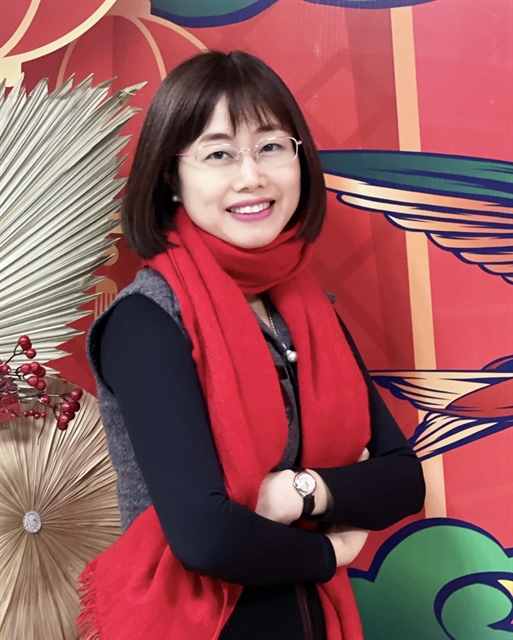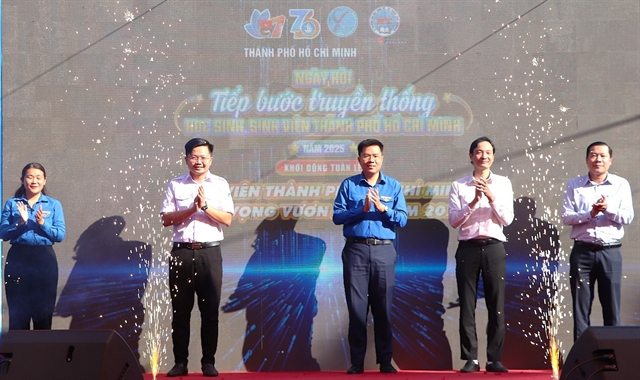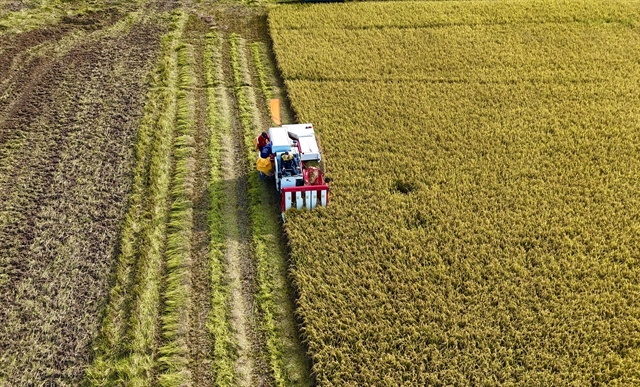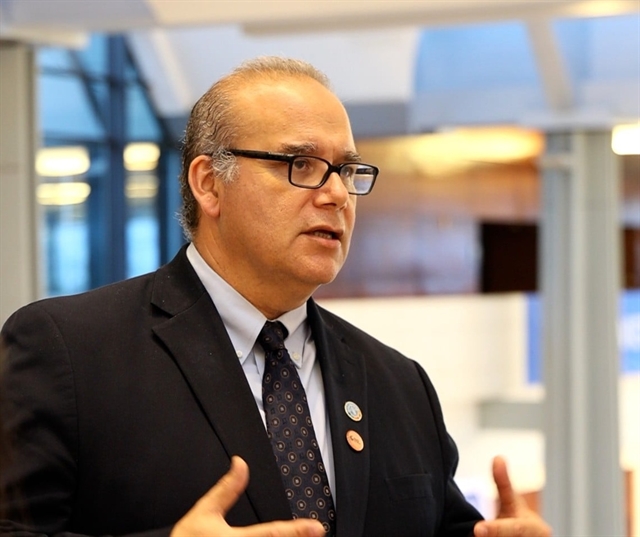 Opinion
Opinion

 |
| Farmers in Châu Phú District, the Mekong Delta province of An Giang, harvest rice under the project for one million hectares of high-quality and low-emission rice. — VNA/VNS Photo Thanh Sang |
Trọng Kiên
The chief economist of the Food and Agriculture Organization of the United Nations (FAO) Máximo Torero talks to the local media about his assessment of, and recommendations for, Vietnamese agriculture, in efforts towards green and sustainable development.
What are the main challenges for countries like Việt Nam in transitioning to green and low-emission agriculture?
The agrifood system is a sector that brings something very important to us, which is the right to food, it allows us to have healthy diets, allowing us to be healthier – not only by reducing undernutrition, but also improving our health, minimising communicable diseases.
But at the same time, the agri-food system brings externalities. Agriculture emits one-third of the greenhouse gas emissions. Agriculture uses water, land, soil and also can affect biodiversity. Those are the challenges. Those are what we call the externalities of what we produce.
What we need to do is to produce sustainably, so that we minimise those externalities. And that has a cost. That's not for free.
The benefit is that we will have food today and tomorrow, where we want good food for all, for today and tomorrow. That's the benefit, but it's an intertemporal benefit. It will take time to get that second benefit. But if we do it in a sustainable manner, if we invest today, which is what Việt Nam is trying to do, then we will also have good food for tomorrow too. So yes, we pay the cost today and we will get the benefits tomorrow and the benefits will be significantly higher than investment.
What are the priority areas of the FAO in its cooperation with Việt Nam?
The FAO has a strategic framework that goes until 2030, and it has a plan for Việt Nam until 2026. Our strategic framework has four pillars, or ‘four betters’ – better production, better nutrition, better environment, and better life.
But we also have accelerators. And the accelerators are science, innovation, data and institutions.
We are working with Việt Nam through the Green Climate Fund and other initiatives to accelerate the process of bringing science and evidence to accelerate sustainability, so that we can produce more with less in a sustainable way.
And we are going to bring as much evidence that we have been working with Việt Nam also in trying to see they will be part of our Hand in Hand Initiative, which is an initiative that tries to use territorial approaches to optimise agricultural production and benefits to farmers, especially small holders, in a way that they can get better returns and move themselves out of hunger and poverty. So, FAO is very committed.
FAO also has a road map. And the road map is to try to bring two objectives together, which is very aligned to the priorities of Việt Nam, UN Sustainable Development Goal 2, which is Zero Hunger, but without breaching the 1.5 degrees Celsius threshold, which is the Paris Agreement.
 |
| FAO's chief economist Máximo Torero. — VNS Photo Bảo Hoa |
Could you share some agriculture models that Việt Nam can follow?
There is no one agricultural model. There are many agricultural models depending on the challenge. Việt Nam has a huge experience in working in agriculture, high-value commodities, food safety standards. I worked in Đà Lạt before, and I saw that you integrate smallholders together in a business corporation, and you're able to have the economies of scale to achieve their goals, and you have the food safety standards, and you need to bring the environmental standards. That's what we expect to happen, but it will depend, in each scenario. What are the bottlenecks and what are the solutions we need to bring? Also assuring that we are taking into account the sustainability component – environmental sustainability, social sustainability and economic sustainability.
My recommendation is to keep moving ahead, try to bring as much science, evidence and data as the Vietnamese Prime Minister has mentioned, so that we can accelerate this process of transformation, because climate events will increase in intensity and frequency so it’s essential that you are resilient to those. And the only way you can be resilient is by having early warning systems so that you can be preventive. And for that, we can work with the government to create triggers for all the risk indicators, and the second component of resilience is to have the capacity of absorption. So, if a shock happens to you – a climate shock, a drought or a flood – you have the capacity to reconstruct and reconstruct better. And that capacity of absorption, you will only get with technology. You’d want varieties which are weather resistant, you’d want varieties which are flood resistant. You’d want varieties that are resistant to the new pests and diseases that will evolve over time.
For climate summits, like the upcoming COP29, green finance has attracted considerable discussions. What is your expectation or prediction for how these discussions will evolve in the future?
When you go to a COP, or any climate forum really, agriculture is seen as the bad element, the sector that comes and creates problems of biodiversity, creates problems of emissions and so on and so forth. That will need to change. Why? Because agriculture, as I said, brings the right to food. It's a very good thing. We cannot have a planet without people. We need to feed people.
But the second thing is that we have this space to improve and reduce those externalities – emissions, and land use, water use, etc. – we have that capacity. If we invest in the agri-food system transformation, we will achieve that.
What is the problem today is that only 3-4 per cent of climate financing comes to the agri-food system. Where is the sector that not only brings you the right to food, but it's a sector that can improve? So that needs to change. The financing needs to go up to 30-40 per cent, we need to keep intensifying investment from the climate financing to the agri-food systems.
How do you think technology and artificial intelligence can have an impact on agriculture? What are some of your recommendations for developing nations like Việt Nam?
In terms of technology and artificial intelligence, we need to understand that it is a horse which is running very fast. And the problem is that you need to find a way to jump onto that horse and to live with that horse, because that horse will run and there is no way we can control it.
In the case of agri-food systems, artificial intelligence can be very useful, and we're doing significant efforts on language models, for example, to try to use all the knowledge we have in science to be able to do extension services.
Here in Việt Nam, if you want to do extension services, the best is to have systems where I can take a picture of the disease of the plant and automatically artificial intelligence can look for the solution and give the farmer, in their local language, the solution.
So, we need to find ways in which we can jump onto the horse and try to control it a little bit through some regulation, but also try to get the benefits, the positive side of artificial intelligence.
Of course, we need to be prepared to minimise the negative side – primarily exclusion – which means that the smallest, the weakest, won't be able to access that technology, because they don't know the language, they don't understand, they don't have the digital technologies to be able to use it. We need to also find ways in which this becomes inclusive to the smallholders.
AI needs to be some sort of global public good that can benefit the small farmers, will benefit the poorest and that will require that countries will have to invest public resources.
For example, in the case of precision agriculture, we know that the large farms can do precision agriculture because they have the scale, so they can pay for the big tractors with satellites and so on and so forth, and they will have information on the weather in real time to make proper decisions. Smallholders won't be able to do it. That's where the government has to help to provide those public goods. And we, FAO, are trying to accelerate that cause.
I think Việt Nam is on the correct path and is evolving properly. They just need to keep strengthening institutions. The recent merger of the two ministries, the Ministry of Natural Resources and Environment and the Ministry of Agriculture and Rural Development (into one entity, the Ministry of Agriculture and Environment), I think, is an excellent idea, because it brings the systematic approach, which is essential. We need to keep working on that.
Việt Nam needs to be competitive, needs to be in the forefront, so that we minimise any potential issues on trade barriers, and so on, so that they can optimise the way they are accessing the world. — VNS